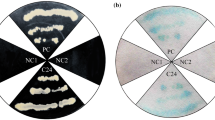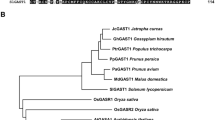Abstract
Aquilaria sinensis is a species of plant endemic to China, which is typical wound-induced economic plant. It is widely used in the production of perfume, incense and traditional Chinese medicine. A healthy A. sinensis tree cannot produce agarwood. It forms agarwood only when wounded. Sesquiterpenes and phenylethyl chromone derivatives have been demonstrated to be the main active compounds in agarwood, but little is known about jasmonate (JA) signaling that regulates the biosynthesis of agarwood sesquiterpenes. In this work, we firstly cloned the full-length cDNA sequence of a JA signaling suppressor gene (JAZ) from A. sinensis, and then characterized its roles through bioinformatics prediction, tissue expression, wounding-induced expression, subcellular localization, protein interaction and overexpression analysis in Arabidopsis thaliana. The results showed that the full-length cDNA sequence of JAZ gene (termed as AsJAZ1, GenBank accession number: KP677281) is 1507 bp, containing a complete open reading frame (ORF) of 990 bp. The bioinformatics analysis shows that the deduced amino acid residues contain a tify (ZIM) domain, the same as A. thaliana JAZ3 protein. Mechanical wounding and MeJA were found to up-regulate the expression level of the AsJAZ1 gene. The AsJAZ1 could interact with the MYC2 transcription factor in vitro. The MYC2 transcription factor in Arabidopsis thaliana (AtMYC2) was minimally expressed in transgenic plants and had a weak response to MeJA treatment. The AsJAZ1 overexpression in A. thaliana was observed to down-regulate the expression of sesquiterpene synthase genes (TPS21 and TPS11), suggesting that AsJAZ1 might serve as a repressor to regulate the expression of sesquiterpene synthase genes in Aquilaria plants. Taken together, this work may lay a foundation for identifying the JA signaling pathway and exploring the role of JA signaling in agarwood sesquiterpene biosynthesis in A. sinensis trees.












Similar content being viewed by others
References
Chen HQ, Yang Y, Xue J, Wei JH, Zhang Z, Chen HJ (2011) Comparison of compositions and antimicrobial activities of essential oils from chemically stimulated agarwood, wild agarwood and healthy Aquilaria sinensis (Lour.) Gilg trees. Molecules 16:4884–4896
Chen HQ, Wei JH, Yang JS, Zhang Z, Yang Y (2012) Chemical constituents of agarwood originating from the endemic genus Aquilaria plants. Chem Biodivers 9:236–250
Cheng AX, Lou YG, Mao YB, Lu S, Wang LJ, Chen XY (2007a) Plant terpenoids: biosynthesis and ecological functions. J Integr Plant Biol 49:179–186
Cheng AX, Xiang CY, Li JX, Yang CQ, Hu WL, Wang LJ, Lou YG, Chen XY (2007b) The rice (E)-beta-caryophyllene synthase (OsTPS3) accounts for the major inducible volatile sesquiterpenes. Phytochemistry 68:1632–1641
Chico JM, Chini A, Fonseca S, Solano R (2008) JAZ repressors set the rhythm in jasmonate signaling. Curr Opin Plant Biol 11:486–494
Chini A, Fonseca S, Fernandez G, Adie B, Chico JM, Lorenzo O, Garcia-Casado G, Lopez-Vidriero I, Lozano FM, Ponce MR, Micol JL, Solano R (2007) The JAZ family of repressors is the missing link in jasmonate signalling. Nature 448:666–671
Chung HS, Koo AJ, Gao X, Jayanty S, Thines B, Jones AD et al (2008) Regulation and function of Arabidopsis JASMONATE ZIM-domain genes in response to wounding and herbivory. Plant Physiol 146:952–964
Clough SJ, Bent AF (1998) Floral dip: a simplified method for Agrobacterium-mediated transformation of Arabidopsis thaliana. Plant J 16:735–743
Fäldt J, Martin D, Miller B, Rawat S, Bohlmann J (2003) Traumatic resin defense in Norway spruce (Picea abies): methyl jasmonate-induced terpene synthase gene expression, and cDNA cloning and functional characterization of (+)-3-carene synthase. Plant Mol Biol 51:119–133
Gao ZH, Wei JH, Yang Y, Zhang Z, Zhao WT (2012) Selection and validation of reference genes for studying stress-related agarwood formation of Aquilaria sinensis. Plant Cell Rep 31:1759–1768
Hong GJ, Xue XY, Mao YB, Wang LJ, Chen XY (2012) Arabidopsis MYC2 interacts with DELLA proteins in regulating sesquiterpene synthase gene expression. Plant Cell 24(6):2635–2648
Huang MS, Abel C, Sohrabi R, Petri J, Haupt I, Cosimano J, Gershenzon J, Tholl D (2010) Variation of herbivore induced volatile terpenes among Arabidopsis ecotypes depends on allelic differences and subcellular targeting of two terpene synthases, TPS02 and TPS03. Plant Physiol 153:1293–1310
Ishiga Y, Ishiga T, Uppalapati SR, Mysore KS (2013) Jasmonate ZIM-domain(JAZ)protein regulates host and nonhost pathogen-induced cell death in tomato and Nicotiana benthamiana. PLoS ONE 8(9):e75728
Kumeta Y, Ito M (2010) Characterization of δ-guaiene synthases from cultured cells of Aquilaria, responsible for the formation of the sesquiterpenes in agarwood. Plant Physiol 154:1998–2007
Livak KJ, Schmittgen TD (2001) Analysis of relative gene expression data using real-time quantitative PCR and the 2 (-Delta Delta C (T)) method. Methods 25:402–408
Niu YJ, Figueroa P, Browse J (2011) Characterization of JAZ-interacting bHLH transcription factors that regulate jasmonate responses in Arabidopsis. J Exp Bot 62:2143–2154
Oh Y, Baldwin IT, Gális I (2012) NaJAZh regulates a subset of defense responses against herbivores and spontaneous leaf necrosis in Nicotiana attenuata plants. Plant Physiol 159:769–788
Oh Y, Baldwin IT, Galis I (2013) A jasmonate ZIM-domain protein NaJAZd regulates floral jasmonic acid levels and counteracts flower abscission in Nicotiana attenuata plants. PLoS ONE 8:e57868
Tamura K, Peterson D, Peterson N, Stecher G, Nei M, Kumar S (2011) MEGA5: molecular evolutionary genetics analysis using maximum likelihood, evolutionary distance, and maximum parsimony methods. Mol Biol Evol 28:2731–2739
Thines B, Katsir L, Melotto M, Niu Y, Mandaokar A, Liu G, Nomura K, He SY, Howe GA, Browse J (2007) JAZ repressor proteins are targets of the SCF(COI1) complex during jasmonate signalling. Nature 448:661–665
Tholl D, Chen F, Petri J, Gershenzon J, Pichersky E (2005) Two sesquiterpene synthases are responsible for the complex mixture of sesquiterpenes emitted from Arabidopsis flowers. Plant J 42:757–771
Willems E, Leyns L, Vandesompele J (2008) Standardization of real-time PCR gene expression data from independent biological replicates. Anal Biochem 379:127–129
Xu YH, Zhang Z, Wang MX, Wei JH, Chen HJ, Gao ZH, Sui C, Luo HM, Zhang XL, Yang Y, Meng H, Li WL (2013) Identification of genes related to agarwood formation: transcriptome analysis of healthy and wounded tissues of Aquilaria sinensis. BMC Genom 14:227
Xu YH, Liao YC, Zhang Z, Liu J, Sun PW, Gao ZH, Sui C, Wei JH (2016) Jasmonic acid is a crucial signal transducer in heat shock induced sesquiterpene formation in Aquilaria sinensis. Sci Rep 6:21843. https://doi.org/10.1038/srep21843
Xu YH, Liao YC, Lv FF, Zhang Z, Sun PW, Gao ZH, Hu KP, Sui C, Jin Y, Wei JH (2017) Transcription factor AsMYC2 controls the jasmonate-responsive expression of ASS1 regulating sesquiterpene biosynthesis in Aquilaria sinensis (Lour.) Gilg. Plant Cell Physiol 58(11):1924–1933
Acknowledgements
This work was supported by grants from the Jiangxi Provincial Natural Science Foundation (20202BABL216071).
Funding
Jiangxi Provincial Natural Science Foundation (20202BABL216071).
Author information
Authors and Affiliations
Corresponding author
Ethics declarations
Conflict of interest
The authors declare that they have no conflicts of interest.
Additional information
Publisher's Note
Springer Nature remains neutral with regard to jurisdictional claims in published maps and institutional affiliations.
Rights and permissions
About this article
Cite this article
Liao, Y., Pan, R., Wei, J. et al. AsJAZ1 represses the expression of the sesquiterpene synthase gene based on the JA signaling pathway in Aquilaria sinensis (Lour.) Gilg. Plant Biotechnol Rep 17, 101–109 (2023). https://doi.org/10.1007/s11816-022-00758-w
Received:
Revised:
Accepted:
Published:
Issue Date:
DOI: https://doi.org/10.1007/s11816-022-00758-w




